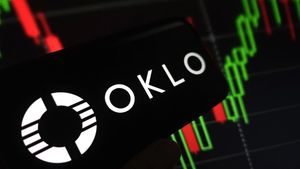
Wall Street is currently a battleground of conflicting sentiments, where immediate caution clashes with an underlying, persistent optimism. This paradoxical mood is a direct response to a rapidly evolving economic landscape, characterized by both undeniable headwinds and powerful tailwinds. Investors are grappling with softening employment data, a cooling housing market, and lingering global growth concerns, all of which counsel a prudent approach. Yet, beneath this surface of apprehension, a robust belief in corporate resilience and the transformative power of artificial intelligence (AI) continues to fuel bullish long-term outlooks.
The immediate implications of this bifurcated sentiment are palpable: heightened market volatility, intense scrutiny of the Federal Reserve's next policy moves, and a strategic re-evaluation of sector allocations. Analysts are advising a discerning approach, urging investors to navigate these crosscurrents with a keen eye on both macroeconomic indicators and the nuanced performance of individual sectors, as the market attempts to price in both an economic slowdown and the accelerating impact of technological innovation.
Economic Headwinds and AI Tailwinds: A Market in Flux
The current economic narrative on Wall Street is a fascinating study in contrasts, where the traditional indicators signal a slowdown while technological innovation promises unprecedented growth. This duality is the bedrock of the prevailing "cautious optimism," a sentiment shaped by distinct economic headwinds and powerful technological tailwinds.
The headwinds are largely visible in softening employment data, which has become a key driver for expectations of a Federal Reserve rate cut. Recent jobless claims have risen more than anticipated, reaching 237,000 for the week ended August 30, the highest since June, while the four-week moving average also climbed to 231,000. Private payroll growth, as reported by ADP, added a mere 54,000 jobs in August, significantly below expectations and July’s 106,000 additions. Moreover, job openings fell to 7.18 million in July, the lowest in nearly a year, and job cuts surged by 39% in August to 85,979, marking the highest August total since 2020. This shift signifies a crucial turning point: for the first time since the COVID-19 pandemic, unemployed individuals now outnumber available positions, a stark reversal from the tight labor market of recent years. The Federal Reserve's "Beige Book" also corroborates these trends, noting "slower hiring" and "more cautious employers" due to weaker demand or uncertainty. This slackening labor market, while potentially easing inflation, increases the likelihood of a 25-basis-point Fed rate cut in September, a move widely anticipated by the market.
Simultaneously, the once-sizzling U.S. housing market is showing clear signs of cooling. While certain regions like the Rust Belt and New England still exhibit appreciation, many "boiling hot" pandemic markets, particularly across the Sun Belt, are rapidly decelerating and experiencing price reductions. The median sales price of new houses sold in July slipped to $403,800, nearly 6% below July 2024 levels. Inventory is on the rise, with active listings up 65.5% year-over-year in January, and new home inventories reaching 499,000 homes for sale in July, pushing supply to a 9.2-month high. Homes are spending more time on the market, and a growing number of sellers (15.3% in January 2023) are reducing their asking prices. This cooling trend, driven by high property prices, elevated mortgage rates (6-7%), and slower population growth, is generally viewed as a healthy market correction, offering increased bargaining power and potentially improving affordability for prospective homeowners.
Adding to the complexity are lingering global growth concerns. The OECD projects global growth to slow to 2.9% in 2025 and 2026, with a concentrated slowdown in major economies like the United States, China, and Canada. The IMF, while projecting stable growth around 3.1-3.2% for 2024-2025, emphasizes that this rate is tepid compared to the long-term average. Risks such as trade fragmentation, new tariff hikes, persistent inflation requiring more restrictive monetary policies, and high levels of geopolitical uncertainty (including potential U.S. tariff increases, conflicts in Ukraine and the Middle East, and China-Taiwan tensions) all cast a shadow over the global economic outlook. China's own economic challenges, stemming from its property sector and weak consumer demand, further contribute to these global macroeconomic headwinds.
Counterbalancing these concerns are surprisingly robust corporate fundamentals. The S&P 500 (SPX) posted an impressive 10.4% year-on-year earnings per share growth in the second quarter of 2025, significantly exceeding the expected 4.9%, with a remarkable 81% of companies beating consensus estimates. Companies generally boast healthy balance sheets, with leverage near decade lows and strong margins, many having capitalized on the low-rate environment of 2020-2021 to secure long-term debt. Resilient consumer spending patterns and solid household balance sheets also underpin this corporate strength, supporting the broader U.S. stock market, which saw one of its smoothest quarters in Q2 2024.
Perhaps the most potent tailwind is the accelerating impact of Artificial Intelligence (AI). AI is widely considered a "once-in-a-lifetime" technological revolution, poised to generate approximately $920 billion in annual long-term economic value for S&P 500 companies (SPX) by 2026, potentially adding $13 trillion to $16 trillion in market value. This transformative technology is driving significant productivity improvements and revenue generation across diverse sectors, sparking massive capital expenditure in chips and cloud services. AI is also fueling a surge in mergers and acquisitions, with deal volumes and values up 33% and 123% respectively compared to 2024, as corporations vie for dominance in an AI-first economy. While currently led by mega-cap tech giants like NVIDIA (NVDA) and Microsoft (MSFT), AI's influence is expected to broaden into industries such as healthcare, industrial automation, retail, real estate management, and transportation. Startups specializing in ultra-low-power AI chips are also attracting significant capital, underscoring investor confidence in this foundational infrastructure. This powerful, broadening impact of AI provides a strong undercurrent of optimism, positioning it as the key catalyst for long-term growth.
Navigating the Crosscurrents: Who Wins and Who Loses?
In this environment of juxtaposed caution and optimism, specific sectors and companies are poised to either thrive or face significant challenges. The interplay of softening economic data, robust corporate health, and the transformative tide of AI is creating a distinct landscape of market winners and losers.
On the "winners" side, sectors historically favored during periods of economic uncertainty and anticipated interest rate cuts are gaining traction. Defensive sectors such as Healthcare (XLV), Utilities (XLU), and Consumer Staples (XLP) are expected to demonstrate resilience due to their stable cash flows and lower sensitivity to interest rate fluctuations. Healthcare, for instance, benefits from consistent demand driven by an aging global population, while utilities offer stable returns and are increasingly seen as beneficiaries of the growing energy demands of AI data centers. Consumer staples, with their reliable demand and often attractive dividend yields, provide a crucial buffer against broader economic slowdowns. Furthermore, the housing market's woes for single-family homes contrast with a stronger Multifamily Housing sector, which is supported by a shrinking homeownership rate and a surge in renter households, particularly in less densely populated areas with lower regulation and land costs. In a world fraught with global growth concerns and geopolitical tensions, Hedge Funds have demonstrated their value as diversification tools, delivering robust returns in volatile markets. Also, sectors tied to Commodities may see increased demand and price stability amidst supply chain disruptions, and companies with a strong domestic focus could benefit from rising trade tariffs and protectionist policies.
Conversely, several sectors and companies face considerable headwinds. The slowdown in Single-Family Residential Construction is leading to job losses and challenges with financing, particularly impacting companies focused on luxury or second-home markets. Some Consumer Discretionary businesses may also suffer as a softening labor market and persistent inflation curb non-essential spending, especially among lower and middle-income consumers. Specific labor-heavy industries, including parts of Trade, Transportation, and Manufacturing, are already reporting job losses, reflecting broader economic adjustments. Globally, Export-Oriented Industries are vulnerable to increased tariffs and trade fragmentation, which can inflate costs and suppress demand. Similarly, sectors with significant exposure to China's economic slowdown, particularly its property sector, face substantial downside risks. Businesses highly sensitive to geopolitical risks, such as those with complex international supply chains, could also experience disruptions, higher energy prices, and heightened uncertainty.
The most profound redefinition of winners and losers, however, stems from the accelerating impact of AI. At the forefront of the AI revolution are Semiconductor Companies like NVIDIA (NVDA) and Advanced Micro Devices (AMD), which provide the essential hardware for AI development and deployment, sustaining momentum through continuous innovation. Cloud Computing Providers such as Microsoft (MSFT) (Azure), Alphabet (GOOGL) (Google Cloud/Gemini), and Amazon (AMZN) (AWS) are direct beneficiaries, offering the robust infrastructure and comprehensive AI services that underpin scaled AI adoption. The demand extends to Enterprise AI Software and Services companies like Palantir (PLTR), which provide AI solutions for automation and data analysis across various business functions. AI is also revolutionizing Healthcare and Life Sciences, accelerating drug discovery and improving diagnostics, and transforming Financial Services through fraud detection, algorithmic trading, and personalized advice. Manufacturing and Industrials are leveraging AI for process optimization and quality control, leading to significant productivity gains. Even Real Estate, specifically in the domain of data centers, is emerging as an "underappreciated play" on the AI boom.
On the other side of the AI ledger are sectors facing significant disruption. Low-End and Labor-Heavy Retail is vulnerable to automation in cashier-less stores and AI-driven inventory management, with a considerable percentage of physical stores at risk of closure. Traditional Customer Service roles are being rapidly replaced by chatbots and AI agents. The Transportation and Trucking industry faces disruption from autonomous delivery systems, threatening hundreds of thousands of long-haul trucking jobs. Administrative and Routine Office Work, encompassing data entry, payroll, and clerical tasks, is highly susceptible to AI automation. Even Traditional Journalism and Content Creation for routine news are at risk as AI models can generate content efficiently. Furthermore, some Legacy Software Companies, despite integrating AI, face investor concerns that comprehensive AI models could reduce demand for their more niche platforms. The Education sector, particularly traditional instructors, may also see their roles evolve significantly with the rise of AI tutors and adaptive learning platforms.
The market, therefore, demands a discerning eye, distinguishing between companies that are strategically integrating AI and adapting to evolving economic realities, and those that are either resistant to change or overly exposed to the sectors facing structural headwinds.
A Paradigm Shift: Industry Impact and Broader Implications
The confluence of economic recalibration and the AI revolution is not merely creating winners and losers; it is orchestrating a fundamental paradigm shift with profound implications across industries, competitive landscapes, and regulatory frameworks. This era draws notable parallels with historical periods of transformative technological disruption, suggesting a future where agility and strategic foresight are paramount.
The current economic shifts, particularly the softening employment and housing markets, point to an evolving relationship between economic indicators and central bank policy. The moderation in wage growth, for instance, offers the Federal Reserve a crucial window to consider interest rate adjustments. A sustained economic slowdown, potentially exacerbated by AI-driven job displacement, could lead to a significant drop in mortgage rates, a scenario historically associated with deeper economic challenges, though AI itself lacks the capacity to directly stimulate housing demand or enact policies. Globally, the prospect of a more protectionist "mercantilist era," driven by new administrative policies and China's ongoing economic challenges, suggests a future of increased trade disruption and price volatility. Fiscal and trade policies are increasingly taking precedence over solely monetary tools, signaling a reorientation of economic management strategies and a move away from unfettered globalization.
However, the most far-reaching impact stems from AI, widely recognized as a "General Purpose Technology" (GPT) akin to the steam engine or electricity. AI's potential to significantly boost productivity, accelerate economic growth, and raise living standards is immense, particularly when combined with other technological trends like robotics and bioengineering. Its adoption rate is unprecedented, with 78% of organizations reporting AI usage in 2024, up from 55% the previous year, fueled by massive private investment. While AI promises transformative productivity, its impact on labor markets is dual-faceted. In the short term, automation of routine tasks could cause significant disruption and job displacement, particularly in metro areas. Yet, historically, GPTs have created more jobs than they destroyed, and AI is expected to follow this pattern in the long run, albeit with a "bumpy" transition characterized by the creation of new roles requiring advanced skills in AI system management, data analysis, and digital design. The integration of AI is not confined to tech; it's streamlining processes, optimizing operations, and enhancing customer experiences across virtually every industry, from healthcare to manufacturing, financial services to home building. The strategic focus is shifting from generic AI strategies to pinpointing practical, ROI-driven use cases.
These developments coalesce into several broader industry trends. We are witnessing an accelerated digital transformation across all sectors, with AI serving as a foundational amplifier. The nature of work is fundamentally shifting from manual tasks to knowledge-based collaboration between humans and AI, demanding continuous learning and upskilling. Globally, an intense race for AI development and technological sovereignty is underway, with the US leading but facing robust competition from China and emerging AI ecosystems. This competition extends to integrating AI into national security and economic policy. An overarching drive for increased automation and efficiency, powered by AI, is reshaping operations from supply chain management to predictive maintenance. Finally, the current economic volatility is leading to a re-emphasis on fiscal and trade policies as primary economic tools, potentially at the expense of globalization.
The ripple effects on competitors and partners are significant. Companies that invest strategically in AI will gain substantial competitive advantages, potentially leading to greater market concentration as larger firms with more resources dominate AI development and deployment. This could disrupt traditional business models, giving rise to entirely new products, services, and ecosystems where AI-powered productivity becomes the new baseline. While AI can optimize supply chains, increased global trade barriers and policy uncertainty threaten disruptions for partners. Furthermore, the widespread use of AI and algorithms for economic decisions, such as pricing, raises concerns among antitrust authorities, like those in the G7, about potential tacit collusion or other anti-competitive behaviors.
Regulatory and policy implications are rapidly emerging. There is an urgent need for public and private investment in workforce retraining and upskilling programs to help displaced workers adapt to new AI-centric roles. Policymakers are intensely focused on ethical concerns such as algorithmic bias, data privacy, intellectual property, national security, and financial stability, emphasizing "responsible AI." The global regulatory landscape is diverse, with the EU's AI Act adopting a risk-based approach, the US focusing on standards and innovation, and China employing centralized governance. The challenge lies in fostering global cooperation amidst these varied approaches. Governments are also increasingly seen as crucial in calibrating policies to stabilize prices, revive economic growth, and manage the AI transition, including infrastructure investment to support AI's computing intensity. Historically, AI's trajectory mirrors past GPTs like electricity: full productivity gains emerge with a lag, though AI's faster diffusion might compress this to 3-5 years. While past technological revolutions eventually created more jobs than they destroyed, the transition can be "painful," with periods of wage stagnation or inequality. The key difference with AI is the potential for a faster rate of simultaneous worker displacement across multiple sectors, making proactive social adaptation through education and policy reforms critically important.
The Road Ahead: Navigating a Transformative Future
The immediate future of the market will be a delicate dance between managing persistent economic headwinds and harnessing the transformative power of AI. Short-term (remainder of 2025 into early 2026), the U.S. labor market is expected to continue its cooling trend, with average monthly job gains potentially falling to 25,000 by Q4 2025 and the unemployment rate possibly drifting towards 4.8% in early 2026. This softening, already evident in a decline in low-paid service work and retail sales jobs, is partly attributed to AI's contributing role in displacing roles involving repetitive tasks, customer service, and administrative work. This short-term labor market disruption, particularly the elimination of some office jobs in metropolitan areas, could temporarily alter housing demand, though AI's long-term promise of increased labor productivity and higher wage growth could eventually re-energize housing and remodeling markets.
Globally, the short-term outlook includes a projected slowdown in U.S. real GDP growth (1.4%-1.5% for full-year 2025, down from 2.8% in 2024), a global manufacturing slowdown, persistent inflationary pressures from tariffs, and potentially elevated interest rates. This could lead to concerns about "tariff-induced stagflation"—a blend of persistent inflation, a weakening labor market, and artificially inflated GDP due to trade policies. However, the long-term view is significantly more optimistic regarding AI's impact on global growth. Analysts from McKinsey & Company and PwC project AI could contribute trillions of dollars to the global economy over the next decade, potentially boosting global growth to 4-6% per annum. Vanguard's global chief economist suggests a 45%-55% chance of an AI-driven surge in labor productivity, potentially leading to a 3.1% real annualized growth rate for the U.S. economy between 2028 and 2040.
Despite economic headwinds, corporate fundamentals remain surprisingly robust, especially in sectors embracing AI. AI has evolved from a promising technology to a fundamental economic force, driving an unprecedented earnings boom and broadening the S&P 500 (SPX) rally beyond traditional tech giants. The AI market is projected to surpass US$500 billion by 2027, with generative AI alone potentially adding $2.6 trillion to $4.4 trillion annually to the global economy. AI is not merely optimizing existing processes; it is catalyzing entirely new business models and industries across healthcare, finance, retail, and manufacturing. However, the full productivity boost is expected to be a "slow-burn," realizing its major impact in the late 2020s and 2030s rather than the immediate next few years.
Strategic pivots are imperative for businesses. An "always-on" strategy, characterized by constant data gathering, insight generation, and rapid pivoting, is crucial. This involves prioritizing AI literacy and upskilling the workforce, redesigning job roles for human-AI collaboration, and establishing robust data governance and ethical AI practices. Businesses must re-evaluate core competencies to augment human creativity with AI, make significant investments in AI infrastructure and talent, and adopt agile methodologies for rapidly evolving strategies. The focus must shift from simply finding AI "use cases" to fundamentally transforming core business functions to capture substantial value. For investors, this means balancing portfolios by maintaining exposure to growth (via AI-related stocks or ETFs) while diversifying with defensive assets like dividend-paying stocks, gold, or Treasury ETFs. Disciplined, long-term investing, rather than reacting to short-term market noise, is recommended, with an understanding that AI's full economic benefits will take time to materialize. Governments and educational institutions also play a vital role in integrating AI education and vocational training to mitigate digital inequality and structural unemployment.
Market opportunities will emerge from continued innovation in AI and tech sectors, the creation of entirely new business models (e.g., specialized roles like Prompt Engineers and Intelligent Agent Managers), and significant efficiency gains across industries. Challenges include job displacement, potential digital inequality, increased technological dependence, ethical and regulatory issues, and the risk of asset bubbles in rapidly growing AI segments. Investors face several scenarios: an optimistic one where AI delivers on its promise of sustained market growth (requiring significant exposure to AI innovators); a cautious recessionary scenario where AI acts as a differentiator for resilient companies (necessitating a balance with defensive assets); a base case of slow-burn AI adoption (calling for long-term, diversified investing); and a pessimistic scenario of AI-induced dislocation (prioritizing capital preservation and defensive assets). The ability to adapt, innovate, and maintain a balanced perspective will define success in this transformative era.
The Balancing Act: Market Outlook and Investor Guidance
The global economic landscape in late 2025 is defined by a dynamic interplay of moderate growth, persistent inflationary pressures, and the profound, yet still unfolding, impact of Artificial Intelligence. Investors are navigating a market characterized by both cautious optimism and underlying uncertainties, demanding a strategic and adaptive approach to capitalize on opportunities while mitigating risks.
Key takeaways from this intricate environment include global growth maintaining a modest 3.3% for 2025 and 2026, with U.S. GDP growth slowing to 1.6% in 2025. Inflation, though expected to decline globally, will see core rates fall more gradually, with the Consumer Price Index (CPI) showing a 2.7% increase year-over-year as of July 2025. The U.S. labor market, while exhibiting a steady unemployment rate of 4.2%, is experiencing a noticeable slowdown in job creation and regional divergence in wage growth. Monetary policy, particularly from the Federal Reserve, remains a critical determinant, with expectations ranging from earlier, deeper rate cuts to maintaining current stances until December 2025. Geopolitical tensions and hawkish tariff discussions continue to pose risks, contributing to global trade policy uncertainty, higher costs, and potential financial instability. Meanwhile, AI is poised to impact nearly 40% of jobs globally, driving massive capital expenditures, particularly in data center infrastructure, and fostering advancements in extra-large language models (XLLMs) and multimodal models (XLMMs). The commoditization of large language models (LLMs) and the shift to edge AI devices are making AI more accessible, even as stronger regulations are anticipated to address ethical concerns.
Looking forward, the market appears poised for constrained yet potentially positive performance. While some analysts anticipate the S&P 500 (SPX) to remain in a trading range between 4,835 and 6,000 for the next 6-12 months, others like Goldman Sachs projects a more optimistic rise to 6,600 in six months and 6,900 in 12 months, driven by expectations of earlier Fed rate easing and sustained large-cap strength. J.P. Morgan expects the S&P 500 (SPX) to close near 6,000 by year-end, supported by double-digit earnings growth. Corporate earnings growth for 2025 is generally expected to be positive, albeit moderated. International stocks have recently shown stronger performance, underscoring the benefits of diversification, especially given U.S. policy uncertainties. While a U.S. recession might be avoided due to robust consumer income, sub-trend growth is possible in late 2025.
The enduring significance and lasting impact of these trends will largely hinge on how effectively governments, businesses, and individuals adapt to AI's transformative power and address its societal consequences. AI holds immense potential to boost economic growth, productivity, and scientific breakthroughs, but its disruptive capacity also threatens job polarization, increased inequality, and market concentration. Responsible AI innovation and policies for workforce adaptation are crucial for shaping a more inclusive future. Persistent trade policy uncertainty and potential politicization of monetary policy represent long-term risks to global financial stability and growth, potentially leading to a more fragmented, yet adaptable, global financial system.
In the coming months, investors should vigilantly monitor several key indicators. Keep a close eye on macroeconomic data, including real Gross Domestic Product (GDP), labor market reports (nonfarm payrolls, unemployment rates, wage growth), and inflation figures (CPI, PPI, PCE). Federal Reserve announcements will continue to be paramount. Track AI adoption rates across industries, focusing on companies leading in AI development and those successfully leveraging AI for productivity. Scrutinize corporate earnings reports and forward-looking guidance for insights into industry health and strategic responses to tariffs and cost pressures. Stay informed about geopolitical developments and trade policy changes, as these can introduce significant market volatility. Given the uncertainties, maintaining a diversified portfolio, including international exposure, and considering sector rotation into AI beneficiaries and resilient defensive plays, remains a prudent strategy. Finally, monitor bond yields, as their trajectory will be influenced by inflation expectations and central bank policies, impacting overall market dynamics. By carefully observing these currents, investors can better position their portfolios to navigate the evolving market landscape.







